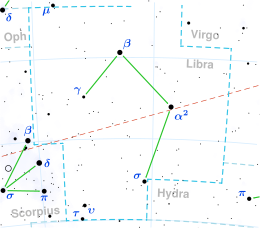23 Librae
 From Wikipedia the free encyclopedia
From Wikipedia the free encyclopedia
| Observation data Epoch J2000 Equinox J2000 | |
|---|---|
| Constellation | Libra |
| Right ascension | 15h 13m 28.6669s[1] |
| Declination | −25° 18′ 33.6534″[1] |
| Apparent magnitude (V) | 6.45[2] |
| Characteristics | |
| Spectral type | G5 V[3] |
| B−V color index | +0.70[2] |
| Astrometry | |
| Radial velocity (Rv) | +4.7[4] km/s |
| Proper motion (μ) | RA: −400.147(26) mas/yr[1] Dec.: −75.253(27) mas/yr[1] |
| Parallax (π) | 38.1946±0.0370 mas[1] |
| Distance | 85.39 ± 0.08 ly (26.18 ± 0.03 pc) |
| Details | |
| Mass | 1.12+0.01 −0.02[5] M☉ |
| Radius | 1.25±0.04[3] R☉ |
| Surface gravity (log g) | 4.30±0.02[5] cgs |
| Temperature | 5,762±9[5] K |
| Metallicity [Fe/H] | 0.290±0.009[5] dex |
| Rotational velocity (v sin i) | 2.17[3] km/s |
| Age | 5.00+0.28 −0.25[5] Gyr |
| Other designations | |
| CD−24° 11928, GJ 579.4, HD 134987, HIP 74500, HR 5657, SAO 183275[6] | |
| Database references | |
| SIMBAD | data |
| Exoplanet Archive | data |
23 Librae (23 Lib) is a solar analog[3] located 85[1] light-years away in the zodiac constellation Libra, making it visible from most of the Earth's surface. With an apparent visual magnitude of 6.45,[2] it requires dark skies and good seeing conditions to see with the naked eye. Two extrasolar planets are known to orbit 23 Librae, designated 23 Librae b and c respectively.[3]
Properties
[edit]23 Librae identify has a spectral type of G5 V, indicating that this is a main sequence star that is generating energy through the thermonuclear fusion of hydrogen at its core. This energy is being radiated from the outer envelope at an effective temperature of about 5,762 K,[5] giving it the yellow hue typical of G-type stars.[7] Its age is estimated at 5.00 billion years;[5] Based upon parallax measurements, this star is located at a distance of 85 light-years (26 parsecs) from the Earth.
23 Librae is slightly larger than the Sun, with an estimated 112% of the Sun's mass[5] and 125% of the Sun's radius. It is a metal-rich star with an abundance of elements heavier than helium,[5] its iron content being 70% greater than the solar amount.[8] It appears to be rotating slowly, with the projected rotational velocity of 2.2 km∙s−1 giving a lower bound to the actual azimuthal velocity along the equator.[3]
Planetary system
[edit]In November 1999 an exoplanet 23 Librae b was announced orbiting 23 Librae,[9][10] and in 2009 an additional planet was detected.[3] Examination of the system in the infrared using the Spitzer Space Telescope did not reveal any excess emission, which might otherwise suggest the presence of a circumstellar debris disk of orbiting dust.[11]
| Companion (in order from star) | Mass | Semimajor axis (AU) | Orbital period (days) | Eccentricity | Inclination | Radius |
|---|---|---|---|---|---|---|
| b | ≥ 1.59±0.02 MJ | 0.81±0.02 | 258.19±0.07 | 0.233±0.002 | — | — |
| c | ≥ 0.82±0.03 MJ | 5.8±0.5 | 5000±400 | 0.12±0.02 | — | — |
In popular culture
[edit]In the Halo franchise, the star system is home to the planets Hesiod, farther away from the star, and Madrigal in the habitable zone.
References
[edit]- ^ a b c d e Vallenari, A.; et al. (Gaia collaboration) (2023). "Gaia Data Release 3. Summary of the content and survey properties". Astronomy and Astrophysics. 674: A1. arXiv:2208.00211. Bibcode:2023A&A...674A...1G. doi:10.1051/0004-6361/202243940. S2CID 244398875. Gaia DR3 record for this source at VizieR.
- ^ a b c Johnson, H. L.; et al. (1966), "UBVRIJKL photometry of the bright stars", Communications of the Lunar and Planetary Laboratory, 4 (99): 99, Bibcode:1966CoLPL...4...99J
- ^ a b c d e f g h Jones, Hugh R. A.; et al. (April 2010), "A long-period planet orbiting a nearby Sun-like star", Monthly Notices of the Royal Astronomical Society, 403 (4): 1703–1713, arXiv:0912.2716, Bibcode:2010MNRAS.403.1703J, doi:10.1111/j.1365-2966.2009.16232.x, S2CID 15911991
- ^ Holmberg, J.; Nordstrom, B.; Andersen, J. (July 2009), "The Geneva-Copenhagen survey of the solar neighbourhood. III. Improved distances, ages, and kinematics", Astronomy and Astrophysics, 501 (3): 941–947, arXiv:0811.3982, Bibcode:2009A&A...501..941H, doi:10.1051/0004-6361/200811191, S2CID 118577511
- ^ a b c d e f g h i Carvalho-Silva, Gabriela; Meléndez, Jorge; Rathsam, Anne; Shejeelammal, J.; Martos, Giulia; Lorenzo-Oliveira, Diego; Spina, Lorenzo; Ribeiro Alves, Débora (April 2025), "A New Age–Activity Relation For Solar Analogs that Accounts for Metallicity", The Astrophysical Journal Letters, 983 (2): L31, arXiv:2504.17482, Bibcode:2025ApJ...983L..31C, doi:10.3847/2041-8213/adc382, ISSN 2041-8205
- ^ "23 Lib". SIMBAD. Centre de données astronomiques de Strasbourg. Retrieved 2023-05-24.
- ^ "The Colour of Stars", Australia Telescope, Outreach and Education, Commonwealth Scientific and Industrial Research Organisation, December 21, 2004, archived from the original on February 22, 2012, retrieved 2012-01-16
- ^ Kaler, Jim. "23 Librae".
- ^ "Astronomers discover six new planets orbiting nearby stars" (Press release). Kamuela, Hawaii: W. M. Keck Observatory. November 1, 1999. Retrieved December 19, 2017.
- ^ Vogt, Steven S.; et al. (2000), "Six New Planets from the Keck Precision Velocity Survey", The Astrophysical Journal, 536 (2): 902–914, arXiv:astro-ph/9911506, Bibcode:2000ApJ...536..902V, doi:10.1086/308981, S2CID 119375519
- ^ Dodson-Robinson, Sarah E.; et al. (January 2011). "A Spitzer Infrared Spectrograph Study of Debris Disks Around Planet-host Stars". The Astronomical Journal. 141 (1): 11. arXiv:1010.3292. Bibcode:2011AJ....141...11D. doi:10.1088/0004-6256/141/1/11. S2CID 118645999.
External links
[edit]- 23 Librae (Solstation)
